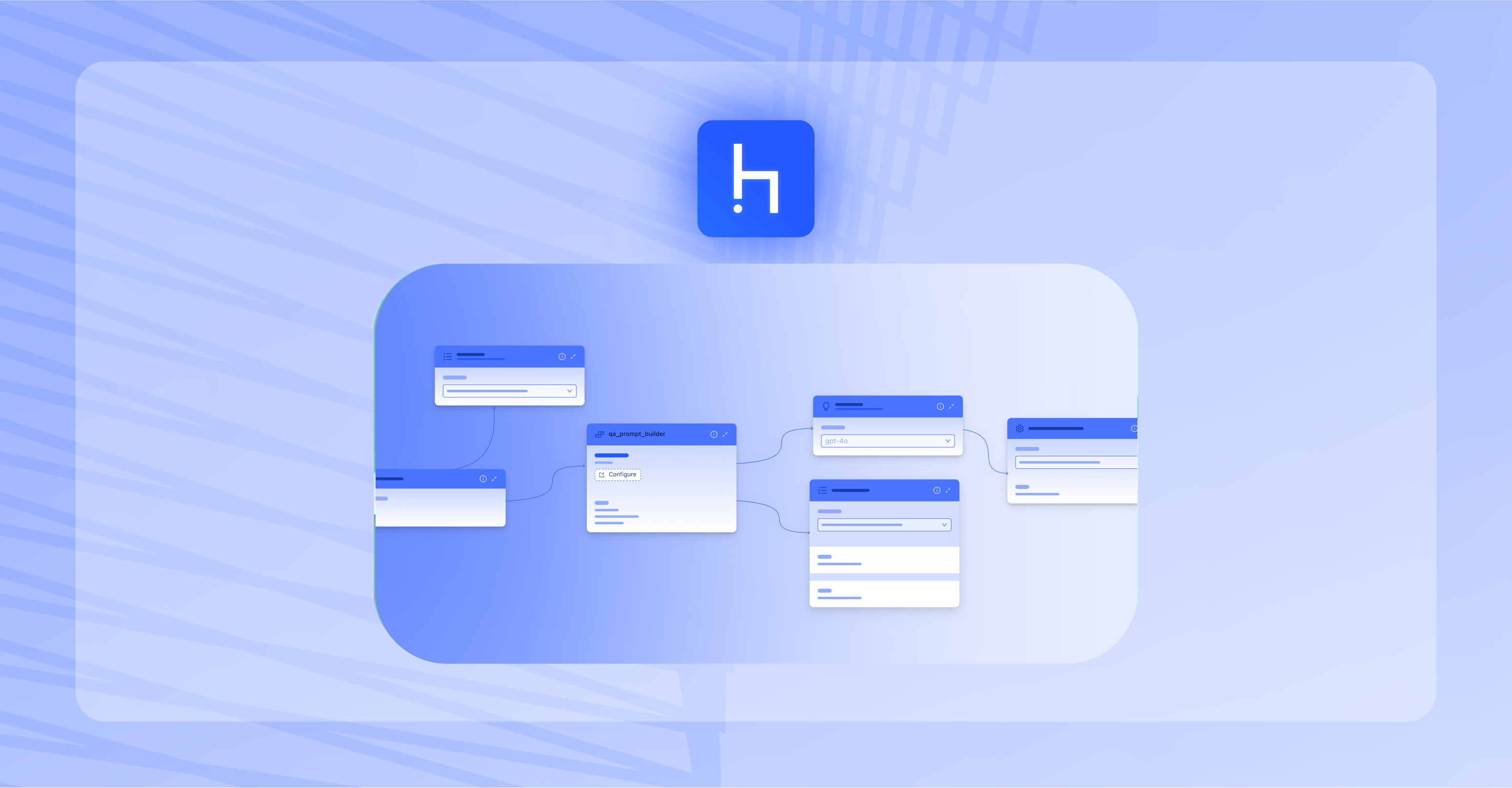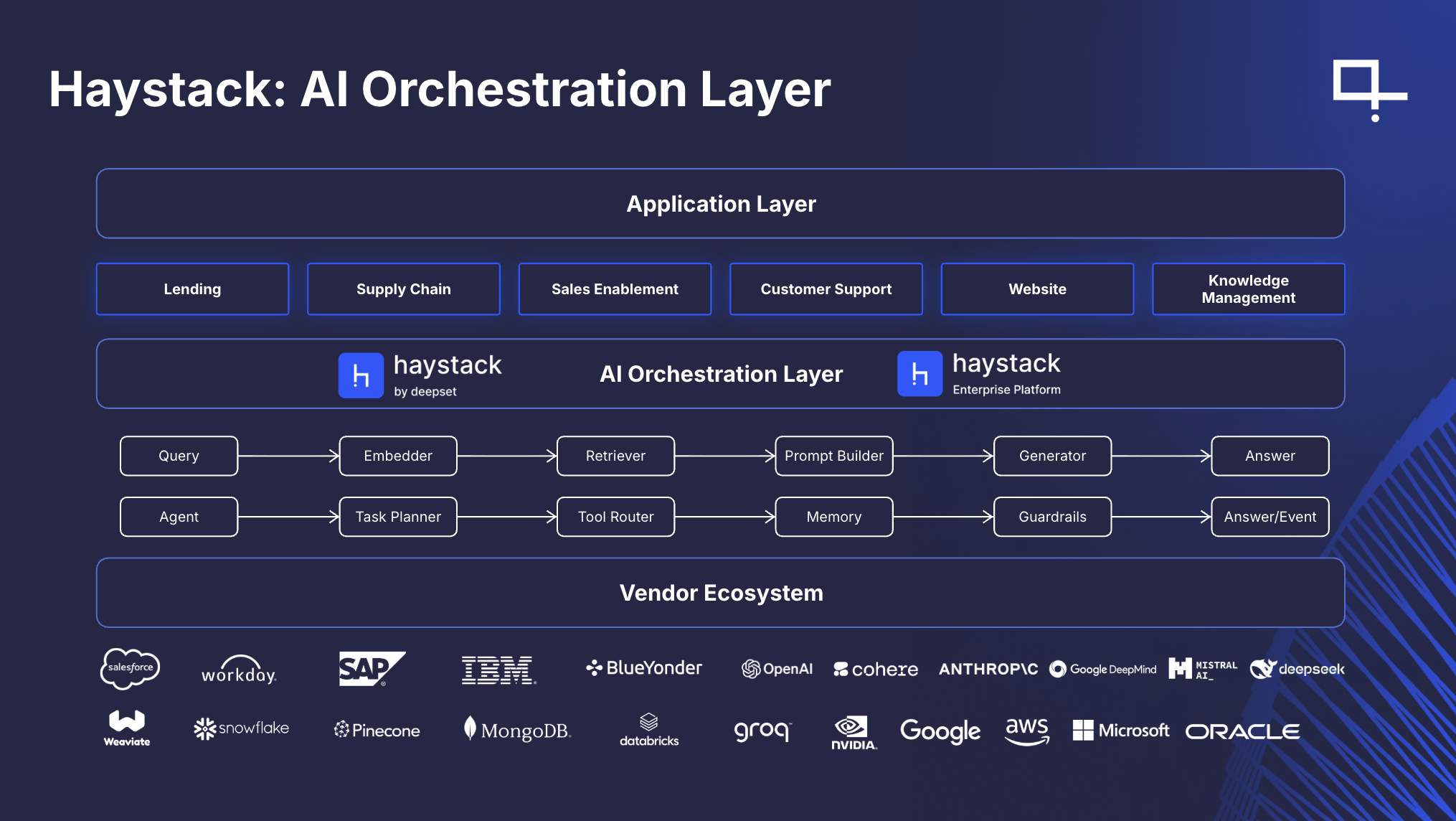

TLDR
Enterprises face mounting decision fatigue as major tech providers push for end-to-end ecosystem lock-in. AI frameworks like Haystack serve as strategic enablers—providing independence, flexibility, and future-proofing by orchestrating across AWS, Azure, GCP, Snowflake, Databricks, Salesforce, SAP, and more. By sitting above these ecosystems, Haystack empowers organizations to mix and match best-in-class capabilities, ensure governance, and scale real-world AI use cases without vendor lock-in.
Key Metrics:
In conversations with technology leaders over the past weeks, one theme has surfaced repeatedly: decision fatigue. Enterprises are inundated with pitches from every major technology player, each offering their own AI stack, platform, or ecosystem. The pressure to commit deeply to one of these providers is intense. Yet, committing too early—or too fully—risks locking organizations into paths that limit flexibility, choice, and ultimately innovation.
This is where AI frameworks, like Haystack, play a pivotal role.
Haystack as a Production-Grade AI Framework
Rather than being another proprietary stack to choose from, Haystack acts as an agnostic virtual layer—a hyper-orchestrator that sits above the major players. Modern AI frameworks provide the connective tissue that allows organizations to harness best-in-class components from across the ecosystem without being married to one vendor. This approach is not just good for technology teams; it’s good for procurement, for governance, and for ensuring AI strategies remain adaptable to market shifts.
What does this look like in practice? Enterprise AI frameworks can:
- Use AWS for compute infrastructure, tap into Azure’s AI services for NLP capabilities, and leverage MongoDB as your vector database.
- Combine Google Cloud’s Vertex AI models with data pipelines already running on Snowflake.
- Integrate applications, such as Salesforce CRM data into AI-driven workflows that also connect to SAP business processes.
- Integrate AI across hyper-scale cloud and and on-prem environments (e.g., NVIDIA with Dell or HPE) for different levels of security across teams and use cases, using a common language that enables consistency, standards, and design repeatability, regardless of deployment.
- Integrate Anthropic’s MPC with standard APIs to build trusted agents that combine elements of the emerging MPC ecosystem with vendor APIs and custom integrations—enabling agents that seamlessly blend deterministic, linear workflows with more flexible, reasoning-based agentic behaviors.

The Benefits of an AI Orchestration
Each of these combinations requires a neutral orchestration layer to make integration seamless, maintain flexibility, and allow experimentation without vendor lock-in. This is especially important for heterogeneous organizations that work with multiple technology partners and have deployment requirements that span cloud and on-prem infrastructure. Leading AI frameworks like Haystack enable enterprises to operate across these diverse environments without compromise.
Why does this matter now?
- Choice amid consolidation: As cloud and AI providers push for end-to-end lock-in, frameworks give enterprises the ability to mix and match.
- Future-proofing investments: With AI evolving so quickly, organizations need to avoid being trapped in yesterday’s paradigm. Flexible AI frameworks make swapping out models, tools, or infrastructure far easier.
- Governance and trust: An independent layer enables more transparent oversight and standardized workflows, critical for enterprise adoption.
- Procurement efficiency: By not being married into any one of the major player ecosystems, CIOs and CFOs can work together to ensure partners are competing most aggressively for their business, lowering costs and keeping positive tension on the full delivery and return-on-investment of each AI project.
The Strategic Power of Frameworks
The key takeaway for CIOs and business leaders: AI frameworks aren’t just developer tools—they are strategic enablers. They provide the balance of speed, safety, and flexibility required to operationalize AI at scale, especially at a time when the market is evolving faster than procurement cycles can keep up.
And this isn’t theoretical—thousands of organizations are already building with Haystack to bring this vision of independence and choice to life. From proof-of-concept through to production, Haystack enables enterprises to harness new innovations as they debut, without constraint. It allows them to adopt real use-case solutions based on the strengths of each provider, weaving together a mesh that spans all major partnerships and ecosystems. Importantly, Haystack also makes it possible to address the challenging parts of your own ecosystem or unique use case requirements by creating and plugging in custom components. For example, a financial services team could build a regulated-document AI workflow with specific compliance checks, or a healthcare provider could integrate a clinical knowledge model tuned for medical language. Whether that’s a proprietary retrieval model, a domain-specific re-ranker, or a custom tool built for regulated workflows, these components can live alongside standard integrations and be orchestrated just as seamlessly.
The Haystack framework was purpose-built to allow this collaboration across architectures such as agents, retrieval-augmented generation (RAG), semantic search, Text2SQL, intelligent document processing, and more. Recently, we launched Haystack Enterprise Starter to make this independence even stronger, with agnostic support provided to companies that seek real-world guidance and support on their AI use cases (e.g., Haystack pipelines) and deployments (e.g., across cloud, VPC, hybrid, or on-prem).
Strategic Analogies for AI Frameworks
What are some good analogies to apply to frameworks? From a strategic perspective, frameworks like Haystack are described as AI Orchestration layers for good reason. Just like the analogy of an orchestra, it puts companies in the place of the conductor, combining different players (e.g., instruments), each playing their part in parallel to create a harmonious, cohesive whole. From a development perspective, you can think of AI frameworks like Haystack as the ultimate AI Lego building blocks set. Imagine if all of the innovations from your vendors were able to contribute a set of their building blocks—data stores, embedding and retrieval models, re-rankers, LLMs, tools, memory, and guardrails.
With this combined set, enterprises can build applications in discrete, orderly components that leverage the best from each vendor, swap seamlessly at any time, and test configurations transparently with full traceability. And from an operational perspective, frameworks act like air traffic control, ensuring every “flight” (AI model, tool, or pipeline) enters and exits the system safely, without collision, and in coordination with the broader ecosystem.
Summary
Enterprises don’t need to marry a single ecosystem to innovate. With the right framework, they can have the best of all worlds—and with Haystack, that freedom and flexibility is already a reality. From premature, locked-in choices at any edge of the ecosystem, you move to the center, where limitless choice is made available, taking advantage of every corner and layer. When you think of AI frameworks, think freedom – and all the advantages that brings for transparency, control, and ultimately AI sovereignty.
{{cta-dark}}
Curious about building AI Apps and Agents?
Table of Contents






